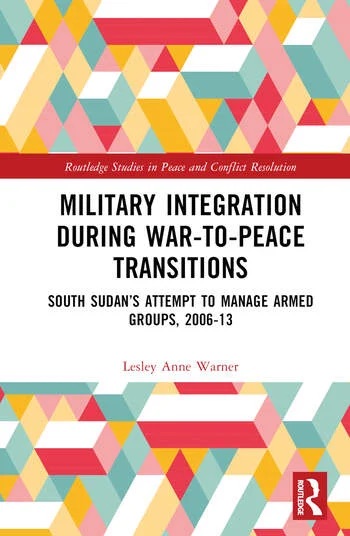New book: Military Integration during War-to-Peace Transitions (Routledge, 2023)
I’m excited to announce that my dissertation has been published as Military Integration during War-to-Peace Transitions: South Sudan’s Attempt to Manage Armed Groups, 2006-13!
In the 1960s, only 10% of peace agreements included some element of political-military accommodation – namely, military integration. From Burundi to Bosnia to Zimbabwe, that number had increased to over 50% by the 2000s. However, relatively little is understood about this dimension of power-sharing often utilized during war-to-peace transitions. Beyond the deep dive into a case of what not to do during war-to-peace transitions, this book provides several contributions to the theoretical and empirical body of literature on how to manage spoilers during fragile transitions – especially during concurrent disarmament, demobilization, and reintegration (DDR) and security sector reform (SSR) processes:
- During such transitions, governments can fight armed groups, ignore them and accept that they lack a monopoly on the use of force within the country, or seek political-military accommodation with them through military integration. In some cases, integration can be the ‘least bad’ option.
- The combination of an open-ended integration process and failed demobilization initiatives can increase pressure on the military integration process.
- A disconnect between the military integration process and broader defense sector reform efforts can contribute to the security sector being rebuilt on an unstable foundation.
- A de facto open-ended military integration process can make it more difficult for a military to focus on cohesion and professionalization, which risks making the force prone to fracturing during periods of heightened political competition.
- Military power-sharing arrangements cannot overcome failed political accommodation efforts, and can even become more vulnerable as political power-sharing arrangements erode.
- Although integration may help warring parties temporarily overcome wartime factionalism and avert conflict in the short term, the process can even contribute to instability if the process is not well-implemented as a transitional security mechanism.
The conclusions I reached were based on interviews conducted in South Sudan, Ethiopia, and Kenya between 2012 and 2014 with individuals who directly managed or facilitated South Sudan’s integration, DDR, and SSR processes between 2006 and 2013.
If you want to grab a copy, use the code AFL02 to receive 20% off until September 30, 2023!
The Disintegration of the Military Integration Process in South Sudan (2006–2013)
Originally published by Stability: International Journal of Security and Development on September 27, 2016)
Abstract: This article argues that military integration served a critical purpose in 2006, arguably preventing large-scale conflict within South Sudan and ensuring a level of stability prior to the CPA-mandated referendum on self-determination in 2011. Nonetheless, integration was poorly-conceived and implemented, and received limited support from third party actors that were more focused on rightsizing the SPLA and transforming it into a conventional, professional military. The de facto open-door nature of South Sudan’s integration process created incentives for armed rebellion, while failed rightsizing initiatives increased pressure on the military integration process as the most expedient way of mitigating the threat these groups posed to stability. Integration thus became an end in and of itself rather than a transitional measure to contain former combatants while the government worked out a more long-term solution for South Sudan’s security sector. Consequently, the SPLA was in a state of arrested development, preventing efforts to transform the military from gaining traction, and making the force more likely to fragment along factional lines during periods of heightened political competition.
(Read the rest here.)
Four Weaknesses of South Sudan’s Military Integration Process
Originally published by Security Sector Reform Resource Centre on August 18, 2015)
In December 2013, South Sudan’s military integration process faced its most serious challenge, as a political crisis that had been developing throughout the year within the ruling Sudan People’s Liberation Movement (SPLM) suddenly escalated, dragging the country into civil war. Within days, Nuer elements of Division 8 in Jonglei state, Division 4 in Unity state, and Division 7 in southern Upper Nile state had defected from the military and formed an armed opposition. These units had been comprised of armed groups that had fought the Sudan People’s Liberation Army (SPLA) during the Second Sudanese Civil War (1983-2005), but had since been integrated into the South Sudanese military. By February 2014, South Sudan’s parliament estimated that up to 70% of the SPLA had defected to the opposition.
The fragmentation of the SPLA certainly escalated the rate at which the political dispute metastasized into the civil war it is at present. However, the fighting that erupted between Dinka and Nuer members of the Presidential Guard and quickly spread to SPLA Headquarters at Bilpam in mid-December 2013 was a reaction to a political trigger. Consequently, beyond simple correlation, there is no evidence of a causal relationship between the government’s decision to integrate armed groups into the SPLA and the political crisis that led to the outbreak of conflict. Rather, a poorly managed, open-ended integration process and the failure of rightsizing initiatives left the SPLA in a state of arrested development, forestalling efforts to professionalize the military from gaining traction, and making the force more likely to fragment along factional lines during periods of heightened political competition.
(Read the rest of the post here.)

You must be logged in to post a comment.